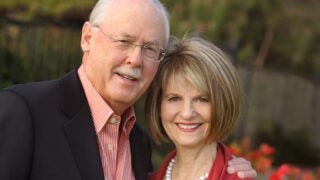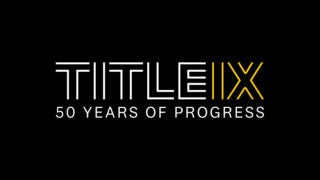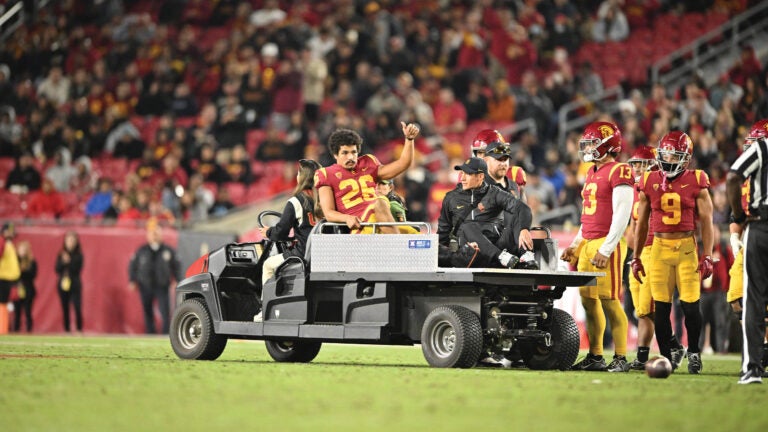
Dr. Alex Weber (center) assists player Travis Dye during a football game in 2022. (Photo/Katie Chin)
Meet some of the doctors healing USC’s athletes
How the orthopedic specialists at Keck Medicine of USC and USC Student Health keep Trojan athletes — and the L.A. Kings — moving.
Charles Mills hoped for a different start to his career on the USC water polo team. In an exhibition match last September against Golden West College, an opposing player’s arm smashed down onto Mills’ wrist as he defended a shot. Initially, Mills says the pain wasn’t too severe. But on his way home that night, the first-year goalie fell off his bike onto that same wrist. The pain kept him up for much of the night.
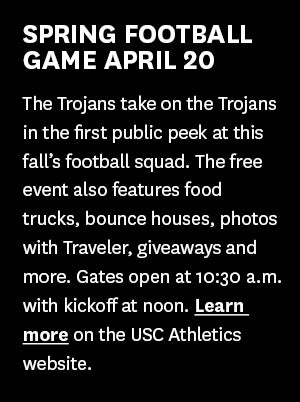 “That next morning, I knew something was up,” Mills says.
“That next morning, I knew something was up,” Mills says.
He immediately visited the USC athletic trainers, who directed him to an orthopedic specialist at Keck Medicine of USC. Seth Gamradt gave him the news: Mills had broken the scaphoid bone in his left wrist.
Less than a month into his freshman campaign, just like that, his season was over.
“I was in complete denial,” Mills says. “I thought I had just jammed my wrist really hard — I didn’t think I’d broken it, let alone that I’d be out two months.”
Although Mills says it was a tough pill to swallow, Gamradt and his team immediately shifted the discussion to recovery.
“Dr. Gamradt and his team comforted me and told me I was going to get through this, which helped me not freak out too much,” Mills says. “I was still completely crushed, but I had complete trust in them.”
A surgery, two months in a cast and some physical therapy later, Mills made a full recovery. He credits it to the care he received from the athletic trainers and health care team in the athletic medicine program at USC Student Health, along with his surgeon Luke Nicholson and the orthopedic team at Keck Medicine of USC. In a sport rife with shoulder and hip injuries and the occasional broken wrist, access to top-notch care is crucial.
The care here, at USC, is completely unmatched. Everything was super organized, and there was full transparency.
— Charles Mills
Fortunately for Mills, his teammates and the roughly 700 other Trojan student-athletes, the athletic specialists from Keck Medicine of USC provide some of the best care in the region.
“The care here, at USC, is completely unmatched,” Mills says. “Everything was super organized, and there was full transparency — I trusted the process, and it worked out 100% well for me.”
His teammate Max Miller — a first-team all-American 2-meter — agrees. He credits the doctors as part of the reason Trojans can continue playing after an injury. “It’s a very comforting feeling to be able to just do my thing in my sport, and then if something ends up happening, I know they’ll find a way to fix it,” he says.
A dream team of sports doctors
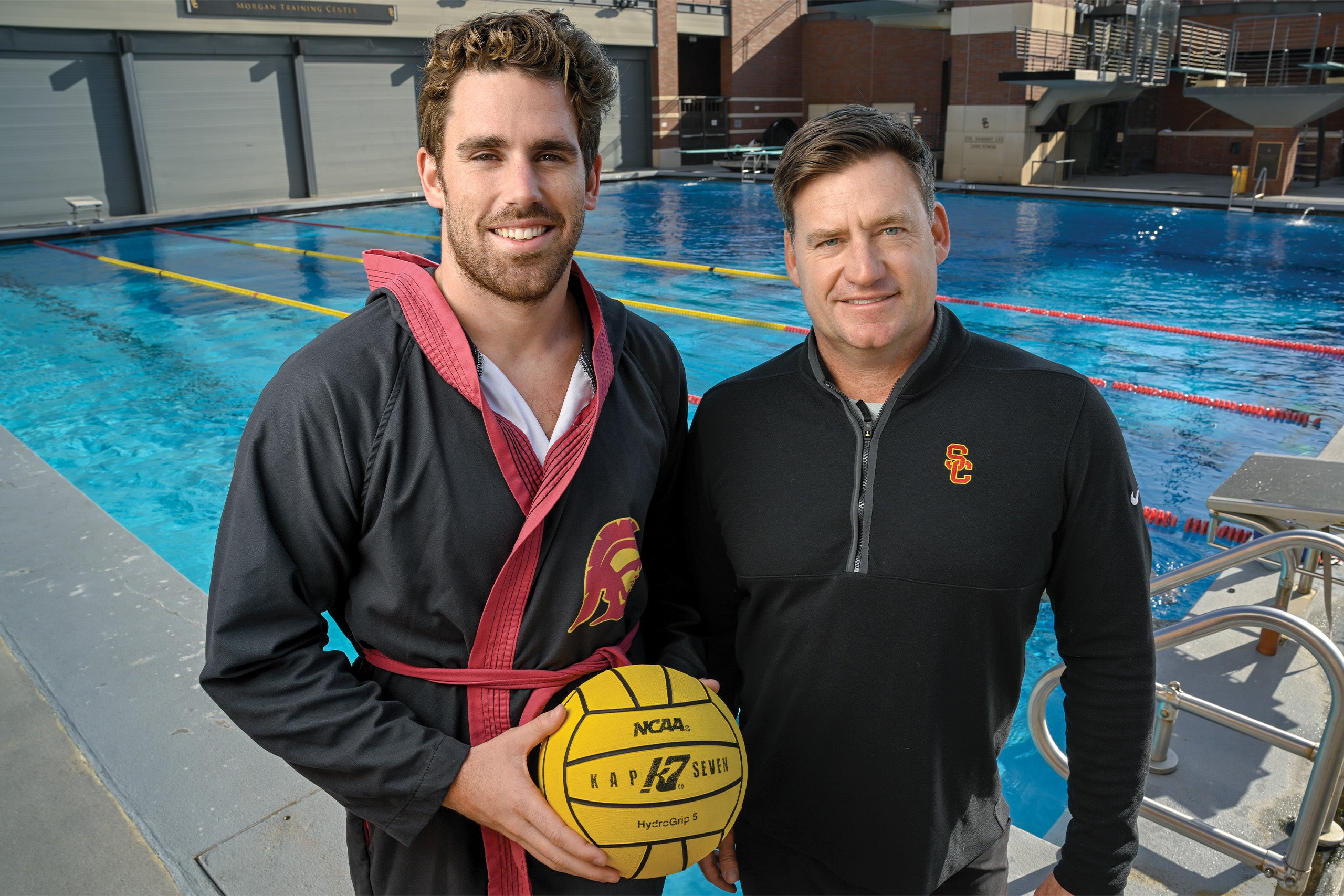
When it comes to athletics injuries, few have seen more than Gamradt and Alex Weber. As orthopedic surgeons and team doctors, they’ve been on the sidelines for championship games and witnessed some of the greatest athletes compete at the highest level.
Gamradt — lead physician for Trojan football for the past 11 years — also worked at the professional level with the NFL’s New York Giants before coming to the West Coast. He is an orthopedic surgeon with Keck Medicine of USC and director of Athletic Medicine, a department in USC Student Health that oversees health care for student-athletes.
“It was an opportunity that I couldn’t turn down,” Gamradt says. “It’s an incredible institution, and the Trojan Family is real — anytime I’m wearing USC gear when I’m out and about, I’ll always get a ‘Fight On!’”
For the past eight years, Weber has served as a team physician for USC Athletics as part of USC Student Health and Keck Medicine of USC, while also serving as a member of the USC Epstein Family Center for Sports Medicine at Keck Medicine of USC. In addition, he is the medical director and head team physician of the NHL’s Los Angeles Kings.
Joseph Liu and Cara Hall have been at Keck Medicine of USC for three years. Both work with the L.A. Kings, and all four physicians provide orthopedic care to all 21 Trojan athletic programs.
“Sometimes it’s an 81-year-old, and sometimes it’s an 8-year-old, sometimes it’s a high school athlete hoping to be a collegiate athlete,” Weber says. “Then sometimes it’s a collegiate athlete trying to be a professional athlete, and sometimes it’s a professional athlete trying to get back to his livelihood. Ultimately, all of those scenarios fall into the same bucket of someone high-functioning losing that function, and getting them back to doing what they love.”
Team mentality
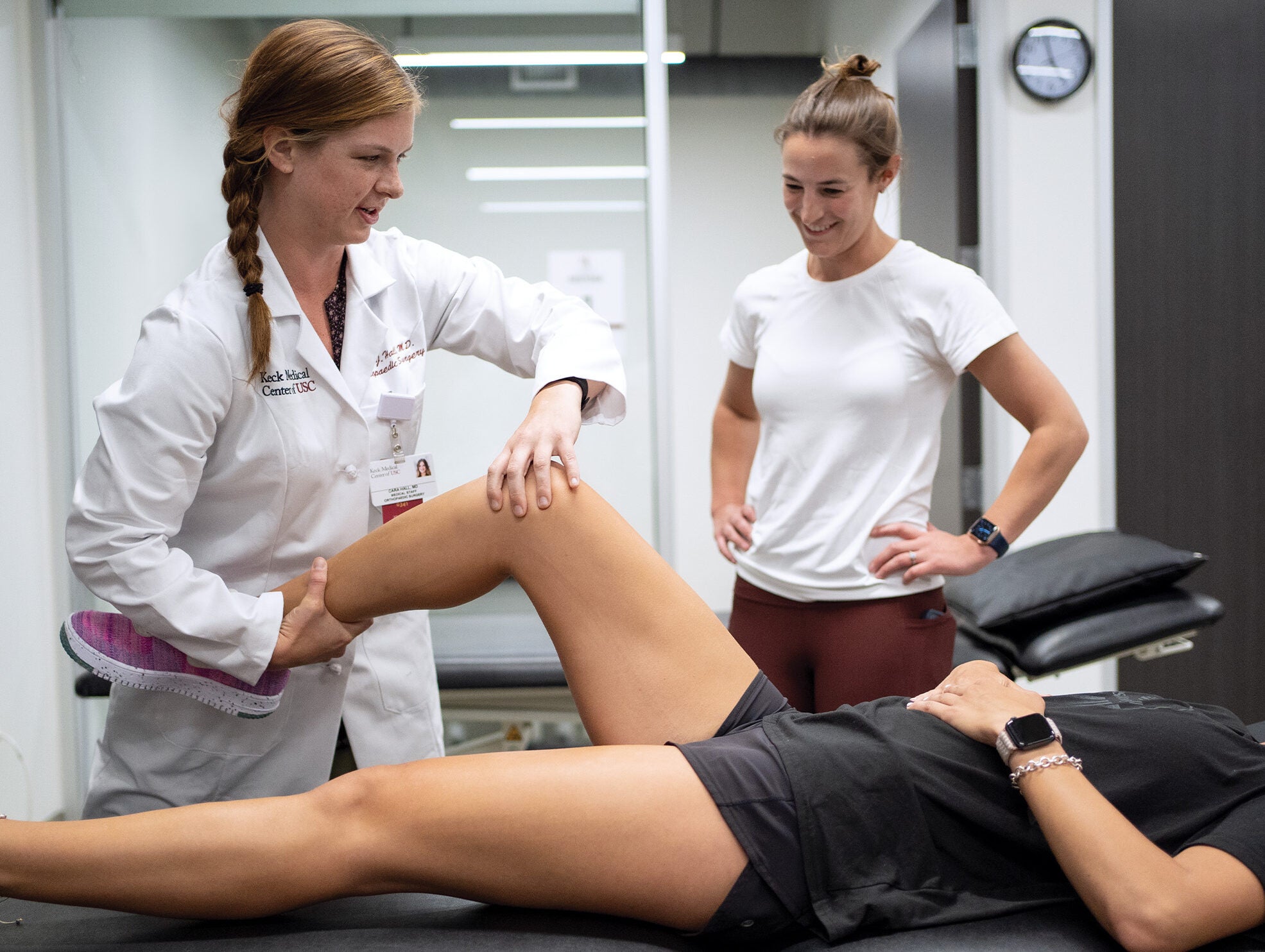
The sports medicine team helps make those moments possible, whether that’s Gamradt working the sidelines of Trojan football games, Weber sitting courtside at men’s basketball games, Hall tending to the Women of Troy in a packed Galen Center or Liu treating the members of the men’s volleyball team.
“Working with the women’s basketball team has really been the best part of the job for me,” Hall says. “It’s such a small team, and we have come leaps and bounds from where we were a few years ago. Seeing them excel at what they do and traveling on the road with them and seeing them make it to March Madness last year — it’s rewarding for everyone involved.”
The team of orthopedic surgery specialists at Keck Medicine of USC are some of the most highly regarded physicians in L.A., so much so that the Kings, a $2 billion NHL team, wanted to partner with them to take care of their athletes.
“One great thing about taking care of the hockey guys is that there’s a culture in hockey that the guys want to play,” Weber says. “We do that within safe parameters — we don’t let people go back when it’s unsafe to be on the ice — but I think the culture in hockey is get fixed up so you can get back out there and play hard for your teammates.”
Sports medicine in the age of social media
As the team of physicians looks toward the future of their profession, they note that social media has had a significant impact on sports medicine, both good and bad.
“There are a lot of what we call ‘Twitter doctors’ who are out there speculating on the injury and how long this athlete’s going to be out. Social media has become the biggest influence on the scrutiny of athletic injuries,” Gamradt says.
For Hall, the increased attention has spotlighted her chosen profession, which she hopes will inspire the next generation of sports physicians.
“The number of students that have reached out to me just from finding my name on the [Keck Medicine] website — medical students or even undergrad students who are interested — has exceeded what I was expecting,” Hall says. “Anyone interested in physiology or kinetics and movement from a science or physical therapy perspective, I think there’s probably a growing interest compared to what it used to be, which is great to see.”
Caring for all
While these doctors have treated their fair share of all-stars and all-Americans, they’ve also treated plenty of weekend warriors. Aside from dealing with agents and the financial implications of a top-level athlete’s injury and recovery, they all say that the mission for treating their patients is the same.
“It’s so hard to pick my favorite part of the job because it’s so multifaceted,” Gamradt says. “I get to teach residents, medical students and fellows how to do surgery. I get to care for patients of all ages and make them better with or without surgical treatment, and then I have the added bonus of being the team physician.”
That type of attitude influences the athletes in return. Whether on the field or off, it’s nice to know everyone’s on the same team.
“I still see Dr. Gamradt and the other trainers around campus, and even my full recovery, they’re always asking me how I’m doing and if I need anything — so, it’s not just a one-and-done deal,” Mills says. “I know that they always have my back.”

